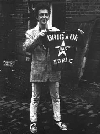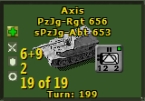IronDuke_slith
Posts: 1595
Joined: 6/30/2002
From: Manchester, UK
Status: offline

|
quote:
ORIGINAL: Zort
IronDuke, those are good ideas. I have been thinking about reducing the length of the current TO's and doing away with the German shock reduction. I was thinking of 2 to 4 turns. Since shock will cover all units and not just the area that you want to attack, shortening the duration of the current TOs is the best option I think. Giving both sides a number of TOs per year is a good thought.
Well, shock is a nice tool, but shock reductions to disadvantage strike me as a double whammy. If command and control breaks down historically, then fine, but the Germans could still run in the winter of 1941. They didn;t because they chose not to. Shock values immobilising entire formations when fronts are breaking up as Winter 41 was supposed to sounds like the double hit. Formations routing would just turn tail and run.
quote:
Hadn't thought about making a SS heavy squad, just have to figure out what a good replacement number would be, how about 50 and reduce the heavy rifle squads the same?
Do we know how many SS formations of Brigade and divisional strength make the game and how many Heer formations of the same sizes make it? I'd be tempted to just express one as a percentage of the other than apply that to the available squads per turn. I'd be tempted to up the SS slightly, perhaps, since the core Divisions were consistently rebuilt and you can't reflect that perhaps with just an average allocation. Certainly by late war, the Waffen SS were press ganging large numbers of men who had never been Waffen SS volunteers. Best example of the top of my head is LSSAH which was rebuilt in early 44 in France with big drafts of surplus personnel from the Luftwaffe and Kriegsmarine. Therefore, a straight allocation is perhaps toom light. However, the kley will be to get the other Panzer and Pzgr formations rated as a higher priority than the infantry formations, and the 1st, 2nd, 3rd and 5th SS divisions rated higher than the rest of the SS.
SS formations also tend to be consistently bigger (3 x btns in Pzgr regiments etc) so you might argue that they deserve slightly higher allocations than the standard Heer equivalents (certainly mid/late war).
quote:
What would you recommend for revamping shock. I have found that anything below 95 for the Soviets will immobilize a good portion of their forces.
Well the house rules preventing movement out of Poland and the Baltic states somewhat arrests the usual Soviet tactic of early withdrawal to a river line so 95 sounds fine. Based on a potted history of the war from memory (as it'll take me hours to cross check the facts), I'd recommend the following re shock.
1941
One Soviet TO for the Winter offensive. I'd lift their shock to the 115 it gets but for only 2-4 turns.
AXIS - I understand they have a general shock level of 115 throughout 1941 except for the initial turns where it is 140. I would give them one TO that raises the shock level to Typhoon level for 2-4 turns, then a return to 100 during the remainder of the winter. I'd raise it to the 1942 level of 105 on turn 73.
The Soviets launched a number of offensives in 1941 into the flanks of AGS at Dubno, into the the flanks of AGN (forget where off the top of my head but Manstein and 56PZKP broke it up) and most tellingly into Guderian's bridgehead at Yelna east of Smolensk on the drive east, and then again all along AGC's front whilst the Panzergruppe were temporarily assisting AGN and AGS (Guderians drive south to meet Kleist and trap 600 000 men at Kiev).
However, whilst earlier assaults were poorly handled and co-ordinated the later ones were better, without being particularly operational. Guderian was forced to withdraw the Yelna bridgehead as the bodies piled up and AGC strained under the weight of heavy punches, but these are attritional blows and I'd argue Soviet shock at 95 is okay, they're only really flinging stuff at the AXIS in headlong assaults.
1942
Here's where it gets a little complicated compared to before and after. The Soviets started to edge towards offensive doctrine on the pre war deep battle model. However, at Kharkov in May, and against AGC during Mars, they get their heads handed to them on a plate. However, later in the year around Stalingrad, they make hay.
So, I'd give them three year-long TO's for 2-4 turns of shock 105, and one TO available in the last 4 months of the year for 110 for 2-4 turns. I'd leave the supply modifiers in place for the winter turns but not tie the Soviet player to attacking during that period.
The German player launched a counterattack at Kharkov, and Blau was essentially 3-4 smaller assaults. So I'd give AXIS 4 TOs that last throughout the year and raise the shock level to 115 for 2-4 turns each. the Germans performed at Kharkov and early Blau about as well as they had the previous year. I wouldn't rate them 120, though, as they currently get.
1943
German general shock is 100 during 1943 if I read the event editor correctly. So give them 4 year longs TO, each of which raise the shock level to 110 for 2-4 turns.
The Soviets are at 105 if I read the event editor correctly. After Citadel, the rest of the year was spent in a series of rolling offensives across different parts of the front. So, give them 6 1943 TOs (starting in June) each of 2 turns.
The effect I'd want to create would be to have the Germans try something during the summer with a TO, but then if/when that came to grief, selectively use their other TOs to counterattack Soviet breaches generated by their TOs.
So, something like, Soviet TO activated in Late July 43 as three Armies attack Stalino. German player rolls with the blow, assembles three PZ divisions via rail and after 5 turns launches his own TO with increased shock to counterattack the Soviet penetration. This is all Manstein really did in essence during 1943 and early 1944, shift and manouver Panzer Divisions to strike blows at the flanks of Soviet OMGs. TO and counter TO, timed to go when reserves were assembled would look very historical IMHO.
1944
Soviets are all over the Germans and have improved out of sight. Deep battle is now entrenched and the Germans are stretched.
6 Soviet TOs of 3 turns raising their 110 1944 level to 120.
2 German TOs raising their 1944 shock level of 100 to 105. They did launch some limited actions attempting to get through to encircled units at Cherkassy etc.
1945
1 German TO raising level to 105. (They did launch offensives towards Hungary at the Gran and Lake Balaton). I'd be tempted to reduce German shock to 98 for this year since they were largely down and out.
General Soviet shock level of 115 would suffice.
quote:
How about the Soviet air. We have numbers of total a/c which means by nov/dec 41 the soviets have air superiority and can win the attrition battle with no problem. I was thinking of reducing the "historical" replacement numbers to the soviets so they will have to make some hard decisions on committing them.
As mentioned earlier, a good idea. The key is to arrange it so the Germans have to start concentrating from the second half of 1942 to get air supremacy and have to concentrate from march 1943 to get air parity. After the start of 1944, there is nothing that should help the Germans.
Regards,
IronDuke
< Message edited by IronDuke -- 3/19/2008 2:22:44 AM >
_____________________________
|
 Printable Version
Printable Version






 That's why I have hit them right from the start...
That's why I have hit them right from the start...


 New Messages
New Messages No New Messages
No New Messages Hot Topic w/ New Messages
Hot Topic w/ New Messages Hot Topic w/o New Messages
Hot Topic w/o New Messages Locked w/ New Messages
Locked w/ New Messages Locked w/o New Messages
Locked w/o New Messages Post New Thread
Post New Thread